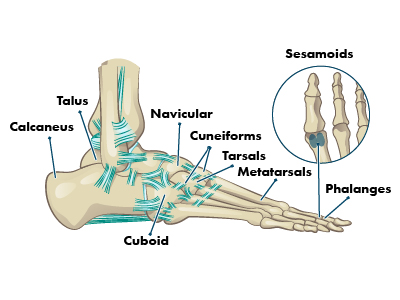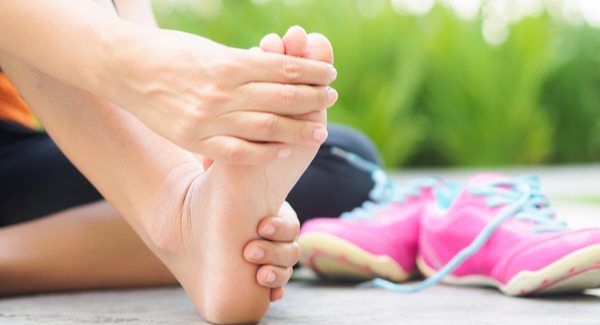Anatomy of the Foot
Feet are the workhorses of the body, providing not just mobility but also balance, stability and support.
Updated by Linda Rath | March 19, 2024
Your feet are a brilliant example of evolutionary engineering. They allow you to walk and run upright while absorbing impact that can be many times your body weight. By the time you’re 50, you’ve likely put 75,000 miles on them. They are highly specialized in structure and function, in part by how many bones are in a foot: 26 bones – about a quarter of all the bones in the body. They include:

Your feet are a brilliant example of evolutionary engineering. They allow you to walk and run upright while absorbing impact that can be many times your body weight. By the time you’re 50, you’ve likely put 75,000 miles on them. They are highly specialized in structure and function, in part by how many bones are in a foot: 26 bones – about a quarter of all the bones in the body. They include:
- Seven tarsals at the back of the foot
- Five metatarsals in the middle of the foot
- 14 phalanges in the toes
Tarsals
The tarsals are a group of bones that form the ankle and the back part of the foot. They include:
- Talus – the main bone in the lower part of the ankle joint. The shin bone (tibia) and calf bone (fibula) make up the upper part. The talus allows connecting bones in the ankle to move in different directions while supporting much of your body weight. The dome-shaped top of the talus is covered with cartilage to make these movements smoother.
- Calcaneus – also known as the heel bone. It’s the largest bone in the foot and the foundation for all the other tarsals and metatarsals. A strong ligament (interosseous talocalcaneal ligament) connects the calcaneus to the talus directly above it and to the calf through the Achilles tendon. It plays a crucial role in weight bearing and it helps flex and extend the foot. Because the calcaneus strikes the ground first, taking the most impact, it’s made of a strong, spongy type of bone. Despite this, repeated pounding can cause minor stress fractures in the bone, especially in runners.
- Cuboid, the main bone in the midfoot. It’s on the outside of the foot near the little toe. It has differently shaped sides that form joints with four other bones, including the heel bone and two metatarsals. The cuboid gives stability to the outer edge of the foot, and though it doesn’t bear weight directly, it helps disperse mechanical force.
- Cuneiforms – three chunky bones (medial, intermediate, lateral) that stretch in a row from the outside to the center of the foot, in line with the first, second and third metatarsals. The cuneiforms make up part of the transverse and medial longitudinal arches of the midfoot.
- Navicular – a boat-shaped bone next to the cuboid bone. It connects the ankle bone to the cuboid and cuneiforms, helps stabilize the ankle and forms part of the medial longitudinal arch.
The foot is complex but learning how it works does not have to be. This article explains the structure of the foot and shows how arthritis can affect different areas. Medical concepts are translated into language that feels clear and useful. Help keep trustworthy health education within reach.
Front and center-front bones
- Metatarsals – five long bones, just below the phalanges or toe bones. You can usually feel these bones with your fingers. Each metatarsal has three parts: a base, a middle shaft and a head that connects to the phalanges. The first metatarsal connects to the big toe and is important for forward movement. The other four metatarsals provide stability to the front of the foot.
- Phalanges – The 14 bones that make up the toes. The phalanges in the feet are similar to those in the hand, but they’re shorter, stronger and less mobile. They’re also shorter than the metatarsals. Like the thumb, the big toe has two phalanges. The others have three – a base, shaft and head. If you’ve ever broken or stubbed a toe or have a structural issue like claw toe – common in people with rheumatoid arthritis (RA) – you know the phalanges and metatarsals are prone to injuries and other problems.
- Sesamoids – two small, pea-shaped bones embedded in a tendon below the first metatarsal (closest to the big toe) on the bottom of the foot. Their job is to strengthen and reduce stress on the tendon.
Joints
Joints are formed wherever two or more bones meet. Each foot’s 33 joints have two essential roles: bearing weight and propelling the body forward when you’re walking or running. To do this, joints must be both stable and flexible. The foot’s flexibility comes from the large number of joints, many of which involve more than two bones. For example, the three cuneiform bones, cuboid bone and the bases of the five metatarsal bones, all connected with ligaments, form a complicated arrangement called the Lisfranc joint complex. Even the toes have several joints – the second through fifth have three joints, while the big toe has two.
The metatarsophalangeal joint (MCP) at the base of the big toe can be a particular problem. It briefly bears half your weight when you push off during walking, and it’s prone to osteoarthritis (OA). It’s also the most common site of gout pain, possibly because it’s far from the heart and one of the coolest parts of the body, where uric acid crystals are most likely to form.
The metatarsophalangeal joint (MCP) at the base of the big toe can be a particular problem. It briefly bears half your weight when you push off during walking, and it’s prone to osteoarthritis (OA). It’s also the most common site of gout pain, possibly because it’s far from the heart and one of the coolest parts of the body, where uric acid crystals are most likely to form.
Tendons, ligaments and muscles
Over 100 tendons, ligaments and muscles hold the bones and joints in the foot together. Tendons attach muscles to bones; ligaments attach bones to other bones. The plantar fascia is the foot’s longest and probably most well-known ligament. It runs along the bottom of the foot connecting the heel bone to the base of the toes. It’s made of fibrous tissue that helps support the arch. When it becomes inflamed, it can cause a deep, stabbing pain that runners, in particular, may be familiar with. There are two kinds of muscles and tendons: extrinsic and intrinsic. Extrinsic muscles and tendons start in the lower leg, wrap around the ankle and eventually attach to the foot, fitting sort of like a sock. They allow the foot to move inward, outward and in other directions. The intrinsic muscles are confined exclusively to the foot. Most spread in layers across the bottom of the foot, where they help support the foot’s arches.
Understanding anatomy gives people a stronger foundation for managing arthritis and working with their care team. Your generosity helps ensure this reliable resource remains accessible to all.

Stay in the Know. Live in the Yes.
Get involved with the arthritis community. Tell us a little about yourself and, based on your interests, you’ll receive emails packed with the latest information and resources to live your best life and connect with others.


